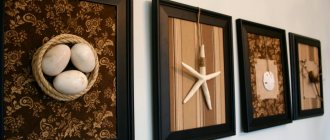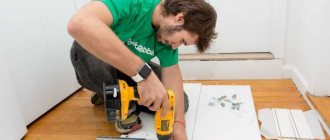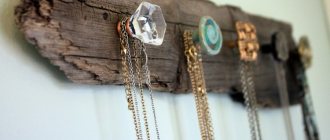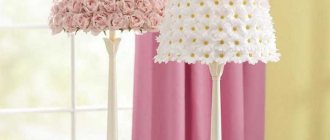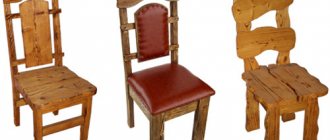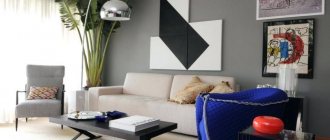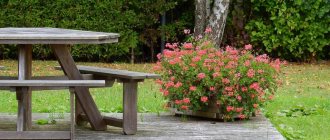Lighting can either transform or make any room uncomfortable. Suffice it to recall cold hospital corridors, and, for example, cafes, where there is always soft warm light.
Especially in winter, people miss the sun, so it is very important that there is always light at home. A special cozy atmosphere can be created with the help of various lamps or floor lamps. However, it is not always possible to choose a lamp that matches the interior of the room. But don’t be upset, because for any lamp you can make a lampshade with your own hands from fabric .
Safety first
Although incandescent lamps have been practically replaced by fluorescent and LED analogues, the risk of a lampshade catching fire due to the light source remains.
Therefore, before making a thematic frame you will have to consider:
- Lampshade composition – the material used should not be flammable;
- Lamp socket - ceramic models are safer than plastic ones;
- The distance between the lampshade and the lamp is at least 9 cm, subject to the previous requirements.
Important! Here are the best options for yellow pendant lights.
As a result, it is better not to use paper, cotton and synthetic fabrics at all. Moreover, no one will monitor the heating of the lampshade every day.
But with prolonged use, even a fluorescent lamp and its socket heat up. Therefore, it is better to use an LED analogue, the power of which can be adjusted.
Types of structures
To create a lampshade, frame and frameless types are used.
- The first type is much stronger, since wire, plastic and even wooden materials are used in the work.
- Wire is suitable for giving different shapes to the lampshade due to its flexibility.
You can also make original models from improvised materials:
- Plastic paper bucket
- Wooden hangers.
Frame made from worn-out products
Making a lampshade with your own hands for a table lamp is easier if you are guided by the shape and dimensions of the supporting base. The latter can be made from scratch or from old products.
In the second case you will have to find:
- Frame from an old unnecessary lamp;
- Wire waste basket;
- Wicker basket made of plastic;
- Plastic bucket of small-medium volume;
- Plastic bottle with a volume of 5 liters or more.
The last option is the most budget-friendly and looks more like a ceiling lamp. However, even transparent plastic can turn into a lampshade after finishing with textiles.
A badly worn frame for a lampshade will have to be treated with your own hands - cleaned of rust, fastened “lame” parts, painted with fire-resistant paint.
Exterior finishing materials
The frame for the lamp is ready, all that remains is to sheathe it and decorate it. For this you will need safe material. It can be found at home among old things.
- Fabric - linen or cotton; synthetics are not suitable, because the heat can melt or change color.
- Yarn or rope. They are best used for wrapping a frame or for a frameless structure.
- The ribbons can be intertwined to decorate the edging of the frame.
- Lace material is selected to create a frameless shade.
- Wooden dies are used to cover the base of the lampshade. These can be planks, slats, twigs.
- Plastic fittings, buttons, and beads are sewn onto the surface to decorate and create a pattern.
Many craftsmen are creative in designing lampshades. They use rings from metal cans, graters, and watch parts.
Load-bearing base from scratch
To make a supporting frame for the lampshade, it is recommended to use copper metal wire. It bends easily and does not heat up as much as its aluminum counterpart.
On the other hand, the remote location of the lampshade from the lamp allows you to use even aluminum wire. The main thing is that its cross-section is at least 5 mm. Otherwise the wire will break.
It’s easy to get wire from copper or aluminum - just cut the cable from old electrical equipment and extract the thematic material from it. If its cross-section is small, then you can weave two or three wires into one. But the solution to the problem of how to make a lampshade with your own hands depends on its shape. The latter happens:
- Conical;
- A-line (skirt);
- Cylindrical;
- Oval.
Obviously, the thematic frame welcomes the upper and lower trims (under the lamp and the bottom of the lampshade) - rings of the same or different diameters. The straps are attached to each other using wire rods.
Actually, the length and shape of the twigs give the frame the desired appearance. But the number and cross-section of vertical elements affect the reliability of the supporting base.
Note!
- Do-it-yourself easel - types of designs, choice of materials for creation + step-by-step instructions and simple diagrams for beginners
- DIY wedding glasses: a detailed master class for DIY decoration, selection of decorative elements and materials (photo + video)
DIY phone stand | Dimensions, features and beautiful options for telephone stands
Floor or tabletop?
By and large, the only significant difference between a floor and table lamp is the length of the leg. For a floor-standing one, as a rule, it is a hollow pin into which the wire is placed, but for a table-top one, options are possible.
You can take a ready-made leg from an old lamp that has fallen into disrepair, or you can make your own unique stand for the lampshade. For example, you can take a plastic vase and make a hole at the bottom for the cable, and at the top - a holder for the cartridge. A floor lamp usually has one leg, but you can make a unique model with several supports, and then it will become a real decoration of the interior, attracting the eye with its unusualness.
Working with wire
First of all, you need to arm yourself with pliers. Even if the lampshade for a table lamp with your own hands has a frame with the finest wire, it will have to be bent and, possibly, braided. The wire cutters cope with this job with a bang.
The question is how to attach the wire elements to each other? Before you do this, you will have to:
- Decide on the area and shape of the lampshade;
- Draw a sketch, then draw a drawing according to the sketch;
- Divide the long wire into several parts according to the sketch.
In addition to wire, in some places you can easily use strips from different products. Moreover, the appropriate combination only contributes to the reliability of the frame.
But you should still attach the wire elements under the lampshade with your own hands for a floor lamp, using the following techniques:
- Bending hooks at the ends of the twigs (it is not necessary to drill holes for the hooks, because you can easily insert thin strips and wire into them);
- Weaving wire around the supporting base (you will have to use a separate thin wire for winding or cut a long length of wire to provide extra space for the braid);
- Welding with a manual gas lighter.
Welding provides a fairly reliable fastening, but requires additional costs for a hand-held gas torch, a cylinder and solder. On the other hand, you can limit yourself to an “Extrapike” pencil. The main thing is that the surface of the wire is free of grease before welding.
Note!
Do-it-yourself busy board: we make interesting educational boards for boys and girls from different materialsDIY photo album - step-by-step instructions for creating a photo album
The most interesting DIY home crafts: a selection of the best interior crafts
As for the wire, you should not skimp on it when braiding. Otherwise, the idea of how to make a frame for a lampshade with your own hands will turn out to be a failure, because... the frame itself will “play” in some places. The same goes for hooks.
To avoid friction of their surface against the base, the tightening must be tight. You can also apply epoxy glue to the assembly.
You can also use a ready-made mesh instead of twigs. Moreover, it is easily formed into a cylinder.
Using a floor lamp in the interior of a room
A simple master class on making a floor lamp will help you independently implement your chosen project and realize your favorite idea.
Beautiful and stylish floor lamps perfectly complement the interior design and the European or American lighting system, while performing several functions at once:
- zoning of space with the allocation of functional areas in the room;
- lighting of the allocated area and local lighting of the space;
- complementing the interior and updating the design made in the same style;
- visually emphasizing the architectural features of a particular room;
- functional addition to the lighting system and bringing comfort to the home.
Fabric lampshade
Having made the frame, you can move on to the task of making a lampshade for a floor lamp with your own hands. Here fabric will serve as a win-win material. The fact is that textiles:
- Easily wrinkles;
- Covers large areas
- Has little weight;
- It is used in various products, making it easy to obtain.
The main thing is that the matter does not ignite. This requirement meets:
- Blackout;
- Satin;
- Jacquard;
- Reps;
- Veil.
These fabrics are often used in making curtains and clothing, so getting them will be easy. Moreover, the pattern will take no more than 1.5 linear meters of material. The center of the resulting segment will serve as the basis for the additive to the frame.
After the additive, depending on your creativity, you can draw wavy ends and other cutouts on the fabric. And don’t forget that fabric serves as an excellent canvas for embroidery, beads, and ruffles.
Master class: painting under a stencil
A lampshade is an important home accessory. Using a ready-made base, you can create original lamps for interior decoration. In the photo you can see different decor options with the same items, but in different designs. The first version of the lampshade is made from a men's flannel shirt, and the second using the stencil technique.
To create a beautiful stencil design you will need a special spray adhesive. You also need to prepare a stencil. For painting, you can use acrylic or latex paints. You will also need special tape to secure the template.
The stencil is attached to the surface using tape. Then paint is applied. The stencil is used to paint the entire surface of the product. To complete the design, you can glue a beautiful blue ribbon. For this, fabric glue is used.
In accordance with the new style, you can also remodel the bedside table. A special spray paint is used for painting. It is better to spray outdoors.
The result should be a combination like this.
Wicker lampshade
A simple thin rope, chain or tape serves primarily as a harness or safety device. But if you divide one of the above-mentioned blanks into segments and weave a fleece from them, then the purpose of the “troika” will expand.
Of course, we are talking about the task of how to make a floor lamp with your own hands. Its lampshade could be:
- Frameless - you need to take a ball or a balloon, wrap it around the sphere, then paste over the braid for rigidity and release the air to remove the workpiece to create a shape;
- Frame - a lampshade cape is knitted or woven from a rope or chain.
The finished cape resembles a small knitted tablecloth. True, the thematic product will have to be given a shape for a high-quality fit on the frame. The shape is set by threading wire rings into the cape and then pressing it by hand or ironing.
An exception is a chain cape, which can take the shape of a lampshade under the influence of its own weight. Moreover, chains can replace vertical rods.
It is enough to attach them to the upper hoop and complement them with imitation precious stones. This technique is also appropriate when you need to make a rope cape with beads.
Choosing a lampshade style
First, the style of the light shade in question should match the style of the room. Round visors or tapered visors are suitable for a classic design. Straight, angular types harmonize perfectly in modern rooms. Trapezoidal styles will suit any style.
Secondly, the contours of the lampshade should be similar to the contours of the lamp itself. The round base and smooth lines fit perfectly with the same geometry of the cap. Square and other similar shapes should match the shape of the lampshade.
Thirdly, the lampshade should not overload the overall perception of the lamp with contrast. For example, for the pompous, sinuous outlines of the entire structure, a modest lampshade in pastel colors is most suitable.
For example, this design turns its attention specifically to the main part - the bottle holder. This is exactly the case when the cap should not be pompous and divert attention to itself
It is quite simple and laconic, carrying the desired intent of the entire composition.
Cardboard lampshade
If the light source uses an LED bulb, then a cardboard lampshade is suitable. The production of the latter occurs as follows:
- First you need to make a sketch and drawing of the future product;
- Next, according to the drawing, corrugated cardboard is cut;
- Drawings are drawn on cardboard using a stencil or independently (geometry, chaotic patterns, romantic hearts, butterflies);
- The designs are cut to create holes through which light will leak;
- A supporting wire frame is created under the future lampshade;
- The cardboard is rolled into a profile tube, covers the supporting base and is installed on the lamp.
At worst, you can simply cover the lamp with a cardboard profile tube without a frame. This technique is appropriate for DIY sconces, as well as tabletop models.
Fabric coverings
The base for work is ready. Now we need to select the material. The main thing is that it is convenient to work with him. Thin fabrics will be successful for work: tulle, taffeta, silk, lace, tulle. They lie softly and form folds.
The tone is selected according to the color scheme of the room. The south side of the home is suitable for cool colors (blue, blue, green). It is good to “insulate” the north of the house with yellow, orange or red. The white color scheme is neutral and will suit any interior.
Wallpaper lampshade
Wallpaper is a fairly dense material made of textiles or paper. This finishing material is easy to cut, wrinkle, and take complex shapes.
If you wrap the finished frame with wallpaper, you will get a quite presentable lampshade, which does not need to be supplemented with anything. After all, the wallpaper already has patterns of a certain color.
But for some, even this performance is not enough. Therefore, you have to paste over your own lampshades from wallpaper:
- Geographical map;
- Photographic film;
- Comic book cutouts;
- Postage stamps;
- Various labels, etc.
The main thing is to maintain at least a 12-centimeter distance between the lamp and the cape. However, the energy-saving lamp itself may not heat up.
Additional tricks
To make a floor lamp with your own hands, you will have to find wood, plastic or metal pipes. But to create a cape, a variety of products and materials will do.
If only at least a little light was sifted through them:
- Wine or beer bottles;
- Iron cans for canned corn;
- Hoop for sifting flour;
- Cups with bowls;
- Kitchen graters.
It is very beneficial to arrange the listed products inside a kitchen or bar - several units in one row on a suspended platform in the form of a wooden board.
And if you need to beautifully illuminate a garage or workshop, then a do-it-yourself floor lamp with a shade in the spirit of steam punk would be an excellent solution. This style is achieved by wrapping a balloon with wire and then welding or gluing washers and gears onto this braid.
Once you've finished your lampshade, we recommend visiting a landscape lighting store.
How to make a floor lamp?
Of course, the designer floor lamps presented in showrooms are distinguished by their originality, practicality and elegance, but, as a rule, many people are somewhat repulsed by these aspects. A floor lamp is associated with warmth, comfort, and spiritual harmony, which is why today people are increasingly purchasing handmade products, into which a piece of kindness is put, rather than mass-produced products.
You can make a floor lamp that will fit perfectly into your interior, will meet all your requirements, and will warm and delight your heart. This will require a minimum of knowledge of electronics, a minimum set of tools and the desire to create a unique floor lamp with your own hands.


